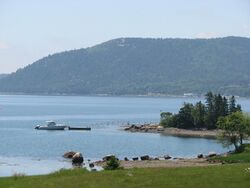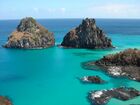Earth:Fjard
From HandWiki
Short description: Glacially formed, broad, shallow inlet

A fjard (Swedish: fjärd, IPA: [ˈfjæːɖ]) is a large open space of water between groups of islands or mainland in archipelagos. Fjards can be found along sea coasts, in freshwater lakes or rivers. Fjard and fjord were originally the same word with the general meaning of sailable waterway. In Scandinavia, fjords dominate along the North Sea coast while fjards dominate the Baltic Sea coast.
Fjards vs. fjords vs. förden vs. rias
Although fjards and fjords are similar in that they are a glacially-formed topography, they still differ in some key ways:
- Fjords are characterized by steep high relief cliffs carved by glacial activity and often have split or branching channels.
- Fjards are glacial depressions or valleys that have much lower reliefs than fjords. Fjards fill with eroded local materials which assist in "filling", along with rising sea level since the last ice age contributing as well. Other low relief landforms that are only associated with fjards, such as mud flats, salt marshes, and flood plains,[1] further characterize the difference between fjords and fjards.
- "Förden" of the German coast and the fjords of Denmark eastern Jutland together form a third type of glacial inlet. They tend to occur along older 'beheaded' river channels and open into the tideless Baltic sea.
- Rias are drowned valleys, such as the estuaries of Thames, Severn and Humber and the firths of Tay and Forth.
Examples
Denmark
- Hjortsholm on the coast of Denmark
Finland
- Airisto in the Turku Archipelago
- Kihti between the Turku Archipelago and Åland
- Porkkalanselkä west from Porkkala peninsula
Republic of Ireland
- Killary Harbour on the west coast of Ireland
Sweden
- Kanholmsfjärden in the Stockholm archipelago in Sweden
United Kingdom
Scotland
- Cree, Kirkcudbrighshrie and Wigtownshire[2]
- Firth of Clyde, Dunbartonshire[2]
- Loch Laxford, Sutherland.
- Rough Firth, Kirkcudbrightshire[2]
- Water of Fleet, Kirkcudbrightshire[2]
Wales
United States
References
- ↑ ABPmer and HR Wallingford. 2007. Understanding and Managing Morphological Change in Estuaries, Ch. 3 of The Estuary-Guide: A website based overview of how to identify and predict morphological change within estuaries., Joint Defra/EA Flood and Coastal Erosion Risk Management R&D Programme. UK Department for Environment, Food, and Public Affairs.
- ↑ 2.0 2.1 2.2 2.3 2.4 2.5 "Error: no
|title=specified when using {{Cite web}}". https://assets.publishing.service.gov.uk/media/602d71ce8fa8f54332e9ff06/Development_and_Demonstration_of_Systems_Based_Estuary_Simulators_-technical_Report.pdf. - ↑ Bird, E.C.F., 2008, Coastal Geomorphology: An Introduction, 2nd ed. John Wiley and Sons Ltd. West Sussex, England. ISBN:978-0-470-51729-1
- ↑ Cooper, J. A. G. (2006). "Geomorphology of Irish estuaries: inherited and dynamic controls". Journal of Coastal Research: 176–180.
- ↑ Jackson, J.A., 1997, Glossary of Geology. American Geological Institute. Alexandria, Virginia. ISBN:0-922152-34-9
- ↑ Goudie, A., 2004, Encyclopedia of Geomorphology. Routledge. London, England. ISBN:0-415-27298-X
 |



